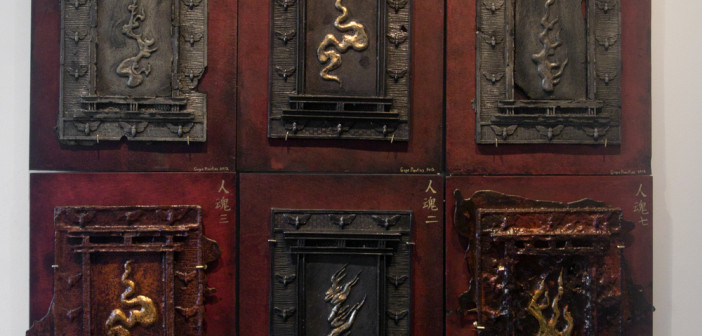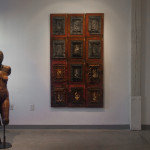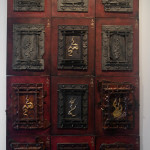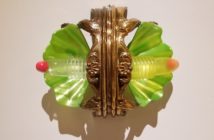Art openings in December are difficult to attend and hold for a simple reason, "other obligations." In the face of the additional responsibilities put on many around this time of year, there are still a few who trudge on, decide to not take this month off, and still show original work instead of leftovers from their inventory for some holiday sale. Here in Providence, Yellow Peril Gallery takes the lead this holiday season and presents a new body of work from artist, Gage Prentiss. Ironically, despite being based in Pawtucket, this is his first solo show in the "Culture Capital."
Hitodama, the Japanese word for the human soul, truly encapsulates the essence of Prentiss’ work in this show. This new body of work, never seen by the public, offers up Prentiss’ inner struggle to understand life cycle without the cliché skeletons, worms, and piles of dirt. This exhibit also marks a shift in Prentiss’ own cycle as an artist and moves away from sculpting and embraces painting, though he abandons neither. His sculptural works bring you into the space and the subsequent paintings you see once you are there tell more of his story, much like a song. One undeniably strong work in the show is the female sculpture in the corner. Her face and some of her upper body is bound with twine, preventing us from looking in her eyes and only making assumptions to her expression. It is impossible to look at her and not hear whispers of Naomi Wolf take on sexuality or Linda Nochlin go on about the male gaze, but despite this work’s perfectly sculpted… well everything and being a feminist’s field day, there is a deep sadness to her that speaks louder than anything else does. Prentiss removed her arms to shield herself and legs to run away, leaving her unprotected to the forces around her. Her presence in the room is both chilling and unavoidable.
Another element to this show is the Asian influence to Prentiss’ work. This is a very dangerous place to tread. Asian influence found in the numerous aisles of Home Goods as well in the beautifully crafted galleries at the Museum of Fine Art, presents the potential for problems. Prentiss courageously walks the fine line of kitsch and the risk works out in his favor. On the far wall of the gallery is a series of twelve different cast iron low relief works hanging in such a way that is resembles a door, though they each work individually. They are a series of sixteen cast works specifically referring to Prentiss’ interpretation of the human soul. Some of the reliefs are better completed than others, but the uniqueness of each attempt hints at a sort of humility in the artist to show his less successful attempts. This is a main reason why these reliefs beautifully tie in with the rest of the show is their reference to one specific insect that Prentiss continuously uses in his paintings and sculptures, the moth.
Before seeing this show, moths meant to me what they probably mean to you, pests. They ruin trees and are kamikaze pilots towards your porch light in the summer, but for some reason in this show, you forget all about that and suddenly they become more gorgeous than butterflies. Sculpturally, the moths are shown at the beginning of their life cycle as larvae. There were a two series of three, a very symbolic number, but while they are literally made out of concrete, resin, and steel, they appeared to look like silver and wood. The moths also appear in several of the paintings and appear to translate the frailty and vulnerability that accompanies the end of life.
Prentiss never forces meaning in any of the works in the show, but the subject matter and quality of the work keeps Prentiss perfectly positioned just behind the curtain where he only reveals as much as he wants to. There was talk at the opening that this show came about as a personal reaction to Prentiss’ mother’s chronic illness. Watching any loved one go through the end stage in their own cycle where nothing can be done except watch is incredibly difficult and this feeling resonates with the sadness of the exhibition. There is no cheery color palette or light subject matter, but there is no feeling of death. Prentiss finds a way of keep the concept of break down from being morbid, but still keeping it from being overly heroic. If this rumor had not circulated around the room at the opening, the conclusion of the theme of Prentiss’ work would still be a sense of mortality.
As the first solo show from Prentiss since 2004, he should breathe a sigh of relief in the success of his comeback. Though this kind of exhibition may not have been the direction the brains behind Yellow Peril might have wanted to go in, this show proves that this gallery is not a one trick pony and is still finding a way to keep things fresh for both artists and audiences. It is important to remember that the art community has its own hitodama as it continues to grow and change to make room for those arriving and leaving the party.
- Gallery View, Photo courtesy of Yellow Peril Gallery
- A selected arrangement from Hitodama 1-14, cast iron, cast concrete, poplar, 2012″ Photo courtesy of Yellow Peril Gallery.
- A selected arrangement from Hitodama 1-14, cast iron, cast concrete, poplar, 2012″ Photo courtesy of Yellow Peril Gallery.







